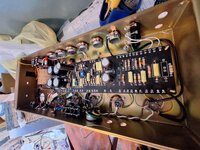So according to MojoTone, the 100k NFB resistor is wired to the 8 ohm output tap of the OT. I was actually asking this question recently here. However, I did read on other places, that their NFB resistor was wired to the 4 ohm tap in their JCM800 RI. Maybe that`s a difference as well.
You could try different cap brands as coupling caps. I just finished a TAD Kit, that is basically a Mojotone Kit, and I`m planing to experiment with different caps. While doing so, I will as well pay attention to the "right" foil orientation when installing the caps. Haven`t done this in the first place.

